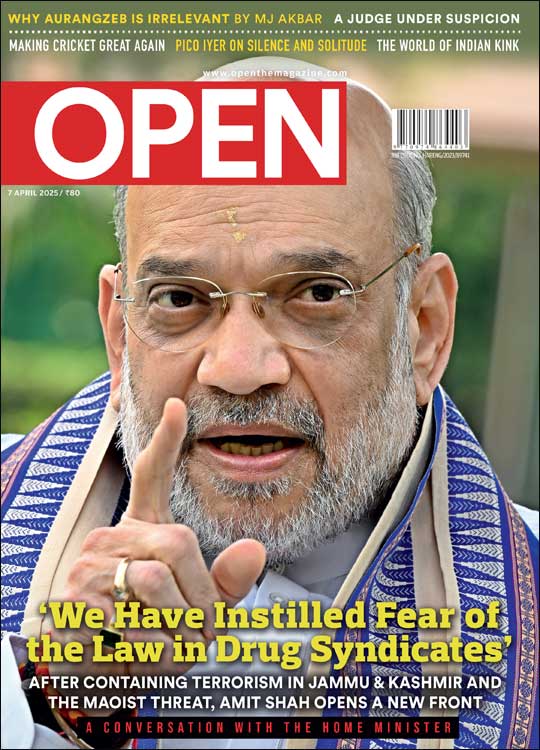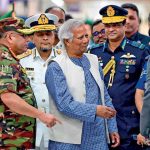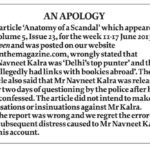The Law That Saved a Billion Lives
A portrait of a fearless piece of Indian legislation that assures affordable medication to the world’s poor
 Sudhir Krishnaswamy
Sudhir Krishnaswamy
 Sudhir Krishnaswamy
|
25 Apr, 2013
Sudhir Krishnaswamy
|
25 Apr, 2013
/wp-content/uploads/2015/11/patent.jpg)
A portrait of a fearless piece of Indian legislation that assures affordable medication to the world’s poor
One day in September 2007, Arun Kumar (1), a serving officer in the Indian Army, took a routine blood test. To his surprise, he found his total leukocyte count (TLC) was at 13,000, a little beyond the normal range (4,000-11,000). The next day, it had climbed to 25,000. Four days later, his TLC had shot up to an alarming 125,000, and he was evacuated from his remote posting in eastern India and flown to a Command Hospital thousands of kilometres away. It was as his doctors suspected: Kumar had chronic myeloid leukaemia (CML). He was lucky for having caught the cancer in its incipient phase.
Kumar was lucky in other ways as well. For one thing, his form of cancer is treatable, thanks to a miracle cure called imatinib. For another, the Armed Forces take care of all his treatment costs while on active duty, and the Ex-Servicemen Contributory Health Scheme (ECHS) will cover him even after retirement. This is no small matter; imatinib is available in generic form from multiple suppliers in India, but a single dose costs Rs 1.2 lakh per annum—and he is likely to stay on medication for the rest of his life.
Despite these advantages, Kumar’s struggle against CML has not been without setbacks. He suffers from chronic indigestion, possibly as a result of his high medicine intake. The Command Hospital he is treated at is overburdened, and frequently runs out of imatinib. During these stockouts, which can last up to several weeks each year, he is on his own: he has to buy imatinib in the market, without reimbursement. Three years ago, his doctors noticed a sudden increase in the chromosomal aberration that indicates CML, and doubled his dosage of the medicine. Still, his body is responding well. Had he instead developed resistance to imatinib, he would have had to upgrade to dasatinib, a newer medicine that Bristol Myers-Squibb (BMS) launched in the market in 2006. BMS, an American pharmaceutical major, markets dasatinib in India under the brand Sprycel at a price of Rs 18 lakh per annum. Natco, an Indian manufacturer, produced a generic version of dasatinib that cost one-eighteenth of the BMS price, at about Rs 1 lakh; BMS sued Natco, and the case is currently in court.
Today, Kumar is alive and well, and his cancer is barely detectable. His annual medicines bill is Rs 2.4 lakh, a sum he can afford only because his employer picks up the tab. That might sound like a large sum of money to expend on one patient alone, but it is in fact the lowest price at which imatinib can be bought anywhere in the world. Hospitals operated by the Forces—like all other government-run health facilities—buy generic imatinib exclusively through competitive tenders; if they were forced to buy Gleevec (spelt Glivec in Europe and other markets), a brand of imatinib marketed by the Swiss multinational Novartis—which introduced the medicine to the world in 2001—they would be looking at an annual bill of Rs 30 lakh for Kumar alone, which is to say, they would have to pay 12 times as much.
Unfortunately, such a price scenario is not idle speculation: until two weeks ago, India’s public health system—funded by taxpayer money—faced the prospect of either instantly multiplying its budget several times over, or, in the case of CML patients, treating only a twelvth of the people it was earlier supporting.
Thankfully, Kumar’s future is safe.
On 1 April 2013, Supreme Court Justices Aftab Alam and Ranjana Prakash Desai upheld previous decisions of the Intellectual Property Apellate Board (IPAB) and the Patent Controller in deciding that Novartis’ application covering a modification to the original imatinib compound was not worthy of patent protection—and thereby, market monopoly —in India. It was a judgment heard around the world. Mainstream media exploded with news of the Indian Supreme Court decision, marking a first for a lengthy document that put forth a complex technical argument based on the arcane workings of intellectual property, itself an arcane subject.
In the flurry of news coverage that ensued, perhaps no fact was mangled as much as the immediate impact of the decision on price and accessibility. The price of imatinib matters, and it matters to us now. In the wake of the judgment, a popular line of argument has been that no matter how low medicines are priced, there will still be millions of people who cannot afford them. This is true, but it is no justification for a higher price: it is a simple consequence of poverty. A low price still matters to the middle-class because it provides them affordable medicines, and it still matters to the desperately poor because it enables foundations, agencies and governments that fund public health to extend treatment coverage to more people who need it.
The other popular line of argument is that this judgment will have no effect on access to imatinib since most people get it free anyway. These exact words have appeared in the editorials and news reports of several publications over the past few weeks, never mind that the opposite is true. Consider the dissimulation that produces this argument. There are an estimated 42,000 people being treated for CML with imatinib in India today. Of these, Novartis claims 16,000 patients use its brand of imatinib, Gleevec. Novartis further claims that 90 per cent of these Gleevec users—about 15,000 patients—get the medicine free through a charitable programme run by the company. (The Cancer Patients Aid Association—CPAA—disputes these claims). Even if we take Novartis at its word, there are at least 27,000 patients—65 per cent of all people diagnosed with CML—who are paying for their imatinib, either directly or via their employers.
Now hear Paul Herrling, head of corporate research at Novartis, conveniently mixing up his numbers, magically expanding the scope of his company’s charity, and setting the narrative: “90 per cent of all people diagnosed with that specific form of leukemia get Gleevec free.”
Regardless of the intent, perhaps we ought to be grateful for the sudden spurt of attention towards Indian patent law. It is well worth understanding. After all, it is the reason we are alive.
The Nobel Prize-winning relief organisation Médecins Sans Frontières (MSF) calls India ‘the pharmacy of the developing world’. It is a well-deserved distinction, and it took the better part of five decades to achieve. The Indian generic pharmaceutical industry took off in the 1970s, and continues to provide patients across India with what are arguably the cheapest certified medicines available in the world. After an early phase of consolidation, the Indian generic industry looked outwards—and began exporting its medicines with some success. Today, large swathes of Latin America, sub-Saharan Africa and Asia (not to mention some sections of the American and European market) depend on Indian generic medicines to a significant extent. An industry born of a straightforward strategy for pharmaceutical self-sufficiency has transformed into a world-class hub of low-cost medicine production.
It was no accident. Like so many transformations that mark our time, it began in the 1960s. Justice Bakshi Tek Chand and Justice Rajagopala Ayyangar, two pioneering patent law reformers of the period, laid the foundations on which the generic industry would be built. The Tek Chand Committee reviewed the Indian Patents and Designs Act of 1911, and argued that it did not encourage scientific research in India. The committee recommended that patents be put to use for the good of the Indian public, and that patented products be reasonably priced, failing which, compulsory licences ought to be issued (which would legally revoke the time-bound monopoly conferred by patent protection).
The Ayyangar Committee took the argument further, noting that far more patents were being granted to foreigners than Indians, and that Indian patents were not proving commercially successful. The Ayyangar Committee asked for the country’s patent law to be redesigned to respond to India’s needs as a developing country, and drew upon European precedents to exempt food, medicines and chemicals from product patents. This legal provision formed the cornerstone of India’s Patents Act of 1970, and enabled the emergence of the generic pharmaceutical industry we know today.
At the same time as Justices Tek Chand and Ayyangar were looking for ways to reform Indian patent law, a nascent pharmaceutical manufacturing base was coming into its own. The Bombay-based generic medicine pioneer Cipla, founded by Khwaja Abdul Hamied, had been operating for 35 years by then. Cipla and other firms of its kind made it clear to the Government that they needed to bypass product patents in order to grow, and it is likely that the presence of a capable manufacturing base hastened the introduction of a law that would help it expand. Once the law took shape, there was no looking back. The Patents Act of 1970 changed the game: the global landscape of medicines was forever altered, and for the better.
The period extending from the 1970s to the early 1990s was something of a golden age for the Indian generic industry. In the absence of binding international treaties that regulated patents, the State was more or less free to do as it pleased, and the generic industry took advantage of this to build its capacity and spread its wings. Then, in 1994, India signed the Agreement on Trade-Related Aspects of Intellectual Property Rights (TRIPs), as part of its accession to the World Trade Organisation (WTO)—and the trouble began. The Indian State had no choice, really; WTO membership was an offer it couldn’t refuse if the country wanted to keep trading with the world.
In Novartis AG vs Union of India, Justice Alam traces the antecedents of Indian patent law. While he does not delve into the frenzied political bargaining that foreshadowed TRIPs, he does reflect on the deep concerns expressed within India—and in other countries reliant on Indian medicines—over the impact of product patents on the domestic generic industry. India’s experience of patents was limited, and the immediate crisis posed by signing up to TRIPs was an existential one: would the pharmacy of the developing world have to shut shop?
In the years following 1994, the Indian State struggled to reconcile its domestic patent law with the international regime it had acceded to. In part, this was because of the commonly held belief that TRIPs forced India to forgo the flexibility to mould its patent law to suit its needs. The feckless thrashing about by the Indian political class in the wake of TRIPs produced several failed ordinances, many aborted legislative attempts, and some modest legal reform between 1994 and 2005. Notably, it was in this period of indecision that the governments of the United States and the European Community launched formal complaints against India at the WTO—in 1996 and 1997, respectively—for failing to fulfil its obligation to provide interim protection to patent applications in advance of a new patent law. (By the terms of TRIPs, India was required to bring its patent law into line by 2005; it was also required to set up an equivalent system in the intervening period.) The WTO upheld the US and European complaints. As a result, India amended its patent law in 1999, setting up a ‘mailbox’ for patent applications and instituting a scheme of Exclusive Marketing Rights (EMR) to serve as a proxy for patent privileges in the run-up to patent protection.
Within the generic pharmaceutical industry, the period between 1994 and 2005 was characterised by confusion. Some generic manufacturers stuck to their guns: Cipla, for instance, made a brilliant, headline-grabbing move in 2001 by offering MSF the cocktail of medicines required to treat HIV and AIDS at a jaw-dropping price of $350 per annum—at a time when the prevailing price around the world was over $10,000. But as India further complied with TRIPs, the effects of full compliance were becoming clearer, and they did not bode well for the industry.
In the end, the demands were met by the 2005 amendment to the Patents Act. Unusually—or luckily—a curious combination of negotiating deadlocks, parliamentary unrest and the strong presence of the Left parties in the ruling coalition resulted in a strikingly bold and original law. The amendments finally made to Indian patent law were a culmination of the policy concerns expressed since 1994.
In his judgment, Justice Alam notes that Parliament paid particular attention to Novartis’ exorbitant pricing of Gleevec—the first medicine in India to have been granted an EMR—and used the experience as a lesson in understanding what could happen under a patent regime of unfettered monopolies. The amendments of 2005 complied with TRIPs and ushered in product patents and yet featured several distinguishing details. Significant among these was a higher threshold for inventiveness, which, while allowing for incremental innovation, demanded that the increment be amply demonstrated in the form of measurably greater efficacy.
At the outset, there was no doubt these largely unprecedented provisions would eventually be challenged. An early exercise to deflect international murmurs about the legitimacy of these provisions was the formation of a Technical Expert Group on Patent Law Issues, headed by Dr RA Mashelkar, the (then) head of the Council of Scientific and Industrial Research (CSIR). The Mashelkar Committee was established in April 2005 and tasked with examining a couple of crucial questions pertaining to the TRIPs-compatibility of Indian patent law. It took its time to deliver.
Soon after, Novartis’ application for patent protection on its beta crystalline modification of imatinib was examined. (The patent on the original compound was instituted before 1995, making it ineligible for consideration under Indian law.) In 2006, the Patent Controller rejected Novartis’ application on the grounds that it failed to satisfy several provisions, including section 3(d) of the Patents Act, which asks for a demonstration of increased efficacy to prove incremental innovation. Novartis appealed the decision to the IPAB, which rejected the application in 2009. As a last resort, Novartis filed a Special Leave Petition under Article 136 of the Indian Constitution to challenge the ruling of the IPAB, and this is how the case reached the Supreme Court.
For 15 years, Gleevec travelled through the courts like a bullet in slow motion fired at Indian patent law. Every step of the process was a cliffhanger; every outcome, at every stage of the challenge, had the potential to directly affect the lives of hundreds of millions of people at home and abroad.
Prior to the Supreme Court decision in this matter, Novartis had approached the Madras High Court, arguing—in a separate but related charge—that section 3(d) of the Indian Patents Act was unconstitutional. In effect, Novartis was trying to do what the Swiss government would not. Instead of the Swiss government hauling India to the WTO—as the US and EU had done before, and as is standard procedure in a sovereign dispute—Novartis was taking the Indian Government to court for violating its obligations to the WTO. In 2007, the Madras High Court rejected Novartis’ charge and declined to rule on India’s compliance with TRIPs. Novartis did not appeal. Curiously, however, the Mashelkar Committee submitted its own report to the Government a few months before the case was to be heard, and its conclusions supported Novartis. In the run-up to the hearing, Novartis brandished the Mashelkar Report as proof of the Indian Government’s complicity in the alleged flouting of international protocol. More curiously, it turned out that the conclusions of the Mashelkar Report were lifted verbatim from a paper commissioned by a lobby group of multinational pharmaceutical companies and executed by a (then) doctoral student, Shamnad Basheer. In the ensuing scandal, the report was withdrawn and Novartis lost a key prop in its argument. (Several years later, the report was rewritten, re-submitted to the Commerce Ministry’s Department of Industrial Policy & Promotion—and accepted.)
The Madras High Court’s ruling was primarily concerned with constitutional rights and goals. In contrast, the Supreme Court judgment of 2013 restricts itself to the discipline of patent law. Contrary to popular opinion, there is no reference made within the judgment to the Constitution or rights of patients. Justice Alam’s summary observation is that Indian patent law promotes breakthrough innovation while restraining monopoly claims for minor innovation—by which he means modifications that are trivial and do not substantially add value to the original innovation.
The historic nature of the judgment cannot be overstated: not only does it justify Indian patent law as it exists, thereby safeguarding access to medicines, it recasts the Indian patent regime as an agenda-setter for innovation, thus giving it the potential to change the game once more.
Twenty years after TRIPs made its début on the world stage, thanks to the Novartis judgment we can now safely say there is wide flexibility available to member states who wish to comply with it. To exploit this, however, and to make the system truly work for innovation and access, the Indian experience suggests that four factors are crucial. One: the intellectual capacity to create alternatives to standard interpretations of TRIPs, which depends on a robust academic and activist structure that is unafraid of originality. Two: organised patient groups and public interest lawyers who bear the moral impetus of an independent civil society; in the Novartis case, the CPAA and the Lawyers Collective played outstanding roles. Three: the driving commercial ambitions of a generic pharmaceutical industry that makes medicines for the domestic market. Four: an independent judiciary that is confident enough to withstand the public-relations onslaught and backroom bullying that typically accompany cases with major global implications.
Innovation is the point of the Novartis judgment. Innovation is also the point of every detractor of the judgment, including Novartis. The detraction is simple: that this spells the end of innovation in India. Behind this prediction of doom is a widely held notion that patents are an index of innovation.
In theory, they are. Patents are supposed to be temporary monopolies awarded by law as an incentive for publicly disclosed innovation. In reality, however, the global patent system has been gamed beyond recognition. In the preceding decades, as India struggled to refine its patent law, other countries turned their patent systems upside down. In the US, Europe and Japan, powerful pharmaceutical lobbies have managed to consistently weaken standards, creating a system that no longer has the capacity to recognise, much less reward, genuine innovation. Minor and mostly inconsequential innovations rule, and it’s a bitter victory, for they win at the cost of breakthrough innovation. A recent report in the British Medical Journal sums up the global research situation for new medicines: ‘This is the real innovation crisis: pharmaceutical research and development turns out mostly minor variations on existing drugs, and most new drugs are not superior on clinical measures.’
If breakthrough innovation is more important than the incremental kind, as common sense indicates, why do pharmaceutical companies overwhelmingly focus on the latter? For one thing, breakthrough innovation takes time and money and necessarily involves a high risk of failure. For another, minor innovation—relative to its investment—produces very satisfying results. In a recent Public Library of Science study, researchers tallied the benefits of secondary patents in the US market from 17 years of data. They found that on average, a secondary patent adds between 6 and 7 years to the patent life of the original compound. To appreciate the financial windfall that a single year’s additional monopoly represents, consider atorvastatin, a blockbuster cholesterol medicine. The American pharmaceutical company Pfizer launched the medicine under the brandname Lipitor in 1996. At its peak, while under patent protection, Lipitor generated $12 billion in annual revenues. The moment it went off patent and had to compete with generic brands, Lipitor’s revenues plummeted to a little over $1 billion. Pharmaceutical companies chase secondary patents because they have the potential to extend monopolies and deliver exceptional returns for relatively little effort, and this is exactly the kind of lopsided incentive scheme that Indian patent law is designed to thwart.
The other big detraction—a detraction that almost wholly constitutes the innuendo around the Novartis judgment—is that Indian patent law is not TRIPs-compliant since it has not had its day at the WTO yet. There are several ways to think about this. First, the Madras High Court’s rebuff of Novartis’ constitutional challenge in 2007 implicitly addressed this question. Novartis did not appeal the judgment. Second, the WTO does not hand out certificates of compliance: a law that is unchallenged at the WTO is, by default, compliant. Third, if another sovereign entity—like the US or EU—wanted to haul India to the WTO Dispute Settlement Body, it has had plenty of time to do so: eight years to be specific. When India dithered on commitments made to the WTO in 1994, the US and EU formally hauled up India at once. They did so because they were confident they had a case—and they won. India was forced to rectify its mistakes. There is a reason the US and EU have not taken India to the WTO over the TRIPs-compatibility of its patent law. It is not that they are thrilled with the law or perfectly sure it is compliant. The reason India hasn’t yet faced a sovereign challenge on its patent law is that scholarship and evidence weighs in favour of its compliance—and no developed country wants to risk losing at the WTO, for a loss would serve as a licence to every country watching to replicate the Indian model with impunity.
And this brings us to the crux of the matter. India represents 1.3 per cent of the global pharmaceutical market by value. We are a poor country, and a resolutely low-cost generics market to boot. Certainly, there is money to be made here; it’s just that the money is little or nothing when set against the industry’s global bottomline. On its own, India cannot improve the way the industry innovates, regardless of the strength of its patent law, because it lacks clout.
The real problem for global majors is the symbolic value of the Supreme Court’s justification of Indian patent law. You will not hear this problem expressed publicly, because expressing it will only make it worse, but rest assured CEOs in London, New York and Basel are worrying about it. The real threat posed by Indian patent law is that other countries may want it too. If that happens on a large enough scale—and it’s a big if—an unjustifiable business model will be upended and we may finally see innovation and access going hand-in-hand.
(This piece draws, in part, on arguments previously expressed by the present authors in The Hindu on April 15, 2013, and by one of the present authors and Kajal Bhardwaj in Business Standard on April 6, 2013, in which the case of the anonymous Indian Army Officer, reported here at length, was discussed in summary. For further perspectives from cancer patients in India on the Novartis case, the Cancer Patients Aid Association has a useful compendium of reports. For a history of actions taken by Novartis over Gleevec in India through the last fifteen years, the Lawyers Collective HIV/AIDS Unit has compiled a comprehensive timeline with commentary.)
Achal Prabhala works on access to medicines; Sudhir Krishnaswamy is with the Centre for Law and Policy Research, and on the faculty of Azim Premji University
About The Author
CURRENT ISSUE
‘We Have Instilled Fear of the Law in Drug Syndicates,’ says Amit Shah
MOst Popular
4

/wp-content/uploads/2025/03/Cover_Amit-Shah.jpg)











More Columns
Yunus and the case of a "land locked" imagination Siddharth Singh
Why CSK Fans Are Angry With ‘Thala’ Dhoni Short Post
What’s Wrong With Brazil? Sudeep Paul